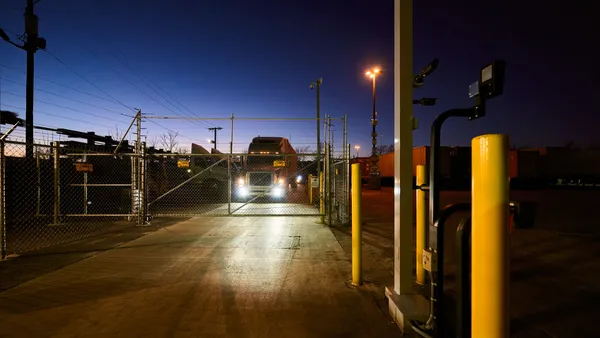Supply chains are constantly changing as new rules, technologies, resources and market trends transform operations. Here's a skim of the week's indexes, technology announcements, expansions and M&As from around the web.
In Case You Missed It
- The first round of NAFTA talks will take place August 16-20 in Washington, D.C.
- Walmart is cracking down on suppliers, demanding on-time, in-full deliveries.
- Congress is taking aim at the ELD mandate, in the latest wave of opposition.
Market Snapshot
The American Trucking Associations on Wednesday released its ATA Freight Transportation Forecast 2017, concluding freight volumes will rise steadily over the next decade, creating a trillion dollar industry by 2024.
ATA found freight volumes will only grow 2.8% this year but grow at a rate of 3.4% until 2023. After that point, the forecast projects more modest growth of 2.3% until 2028. The high initial growth is due to a growing U.S. population and strengthening economy. After that point, the forecast projects more modest growth of 2.3% until 2028.
However, the forecast was not all roses. The next 10 years will also see some "shortfalls," as growth will test freight handling capacity unless executives anticipate a tightened supply. In addition, the trucking industry will see its share of freight tonnage drop to around 67.2% by 2028 as new pipelines steal market share.
Overall, the forecast highlights the supply chain's ties to a rebounding economy and the need for data-based capacity investments.
However, recent statistics suggest industry executives across the major modes are generally scaling back capacity in efforts to become more profitable and inflate rates, as they recover from a major freight recession. Freight's winter may be over, but companies must recover losses and reap the benefits of sustained demand before major investments are made once more.
Technically Speaking
At the FIA Formula E electric street races in Brooklyn, NY last week, DHL discussed how more companies in the transportation industry can achieve sustainability while simultaneously streamlining their supply chains and producing greater cost savings. DHL presented several technological innovations it is testing in warehouses worldwide, including the Parcelcopter (a delivery drone), the EffiBOT (an AI cart to assist warehouse picking), and smart glasses.
But DHL isn’t the only company testing the use of smart glasses for business use: Google parent Alphabet announced earlier this week that it is testing smart glasses for business use with Boeing, General Electric, and Volkswagen, tapping into a growing trend among many large companies to implement automation, AI, and AR in supply chains.
In other news, Maersk and FedEx’s TNT Express are still struggling with fallout from the Petya cyberattack at the end of June. Maersk, whose IT systems have been hobbling along since the attack, petitioned the Federal Maritime Commission (FMC) for a filing exemption, which the FMC granted under certain conditions.
Breaking Ground
Walmart announced plans Tuesday to build a new 2.2 million square foot e-commerce fulfillment center in Davenport, Florida, which the company said will create 1,500 jobs. The warehouse is part of an expansionary project in Florida totaling more than $450 million, according to a press release. The project is part of Walmart’s plan to compete with Amazon; the company hopes the new warehouse will provide faster and better shipping options for its online customers and will help its growing e-commerce business continue to thrive.
As brick-and-mortar Walmart enlarges its e-commerce presence, Flexport, a previously all-online freight-forwarding company, will open its first warehouse — at 100,000 square feet — in Los Angeles on Aug. 1, according to the Wall Street Journal.
In other news, XPO Logistics plans to occupy an empty 1.2 million-square-foot warehouse in Lebanon, Indiana, after the Lebanon City Council unanimously approved more than $2 million in tax incentives for the project, according to the Indianapolis Business Journal. The Houston Chronicle also reported that “nearly a dozen” big-box distributors are investigating the Houston area for warehouse space larger than 500,000 square feet, suggesting that big e-commerce companies, freight-forwarders, or retailers may be trying to break into the Houston market.
Mergers & Analysis
The logistics industry is preparing for sustained growth through a renewed focus on acquisitions.
XPO Logistics, which rose to become a top carrier after a series of acquisitions, has made it clear it is looking for new targets this year. But first, the company needs to raise more capital. DC Velocity reports the company will issue 11 million shares, or 10% of its total shares outstanding. Valued at $60.92 per share at press time, the move would raise a significant amount of money to fund a future acquisition.
But just how expensive is a good deal? Most logistics acquisitions fall in the hundreds-of-millions of dollar range. As an example, J.B. Hunt this morning announced it would buy Special Logistics Dedicated for $136 million. The company provides pool distribution services at 14 terminals and fulfillment centers, according to the company.
Yet, full purchases are not the only way to grow, as shown by Kuehne Holding. The company, which operates well-known global forwarder Kuehne + Nagel, recently increased its share in Hapag-Lloyd to 17.15% from a previous 14.1%, American Shipper reports.
In short, as the economy improves and following a season of weak rates, logistics companies are taking the opportunity to increase service offerings and market share through a diversified portfolio. Certainly, news of mergers are far from over.






















